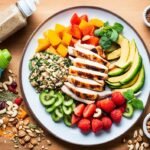Table of Contents
ToggleDry heat cooking methods are a popular and effective way to cook food, providing both health benefits and a delicious taste. These cooking techniques involve exposing food to high temperatures without the use of added moisture, resulting in browning and caramelization, which enhances flavors and textures.
There are various dry heat cooking methods that you can utilize in your kitchen, including roasting, grilling, broiling, and frying. Each method offers its unique qualities and can be applied to a wide range of foods, from meats and poultry to vegetables and fish.
In this article, we will explore these different dry heat cooking methods in detail, highlighting their benefits, techniques, and best practices to help you master the art of dry heat cooking.
Key Takeaways:
- Dry heat cooking methods involve cooking food at high temperatures without added moisture.
- These methods help to brown and caramelize food, resulting in enhanced flavors and textures.
- Dry heat cooking methods include roasting, grilling, broiling, and frying.
- They can be used for a variety of foods, such as meats, poultry, vegetables, and fish.
- Mastering these cooking methods allows you to create flavorful and nutritious meals.
The Benefits of Dry Heat Cooking Methods
Dry heat cooking methods offer several benefits. These methods allow for the natural flavors of the ingredients to shine, as there is no added moisture to dilute the taste. Dry heat methods also help to create a crispy, browned exterior while retaining moisture inside the food. This results in tender and flavorful dishes. Additionally, dry heat cooking methods can be used for a variety of cooking times, allowing for flexibility in the kitchen.
| Method of Cooking | Description |
|---|---|
| Roasting | Cooking food in an oven using dry heat, generally at higher temperatures. Ideal for larger cuts of meat, such as roasts and whole poultry. |
| Grilling | Cooking food directly over high heat, usually on a grill. Great for burgers, steaks, vegetables, and more. |
| Broiling | Cooking food using high heat from above. Perfect for quickly cooking thin cuts of meat, fish, and toasting garlic bread. |
| Pan-Frying | Cooking food in a hot pan with a small amount of oil or fat. Suitable for thin cuts of meat, fish fillets, and vegetables. |
| Sautéing | Cooking food quickly in a small amount of oil or fat over high heat. Ideal for stir-frying vegetables, browning meat, or preparing dishes like risotto. |
Dry heat cooking methods provide versatility in the kitchen, allowing you to explore different cuts of meat, vegetables, and cooking techniques. Whether you’re roasting a whole chicken or grilling juicy steaks, the dry heat method can elevate your dishes to new heights.
Exploring Different Dry Heat Cooking Methods

When it comes to cooking methods, dry heat offers a wide range of techniques that can enhance the flavors and textures of your dishes. Let’s explore some of the most popular dry heat cooking methods:
1. Grilling
Grilling involves cooking food over direct heat, typically on a grill or barbecue. The high heat creates a delicious charred exterior while sealing in the natural juices of the food. Grilling is perfect for meats, fish, vegetables, and even fruits. It’s a versatile method that brings out unique smoky flavors.
2. Broiling
Similar to grilling, broiling uses high heat but from above the food. It’s a quick and convenient method commonly used in ovens. The intense heat creates a crispy top layer while keeping the inside moist and tender. Broiling is great for steaks, fish fillets, and melting cheese on top of dishes.
3. Baking
Baking involves cooking food surrounded by dry heat inside an oven. This method is ideal for slow and even cooking, making it perfect for bread, pastries, casseroles, and desserts. With lower temperatures, baking allows flavors to develop gradually and evenly, resulting in deliciously tender and flavorful dishes.
4. Roasting
Roasting is similar to baking but requires higher temperatures. It’s typically used for larger cuts of meat, whole poultry, and root vegetables. The high heat helps to create a golden crust on the outside while keeping the inside moist and tender. Roasting enhances the natural flavors and brings out rich aromas.
5. Sautéing
Sautéing involves cooking food quickly in a small amount of oil or fat over high heat. This method is perfect for vegetables, meats, and seafood. The quick-cooking process seals in the juices and adds a nice crispy texture to the food. Sautéing requires constant stirring to ensure even cooking and prevent burning.
6. Searing
Searing involves quickly browning the surface of the food in a hot pan before finishing it with another cooking method. It creates a flavorful crust while retaining the natural juices inside. Searing is commonly used for steaks, scallops, and poultry. The caramelization adds depth and complexity to the dish.
Each dry heat cooking method offers its own unique benefits and flavors. From the smokiness of grilling to the tenderness of roasting, these techniques allow you to explore a world of culinary possibilities. Choose the method that suits your ingredients and desired outcome to create delicious and satisfying dishes.
Mastering the Art of Grilling
Grilling is a popular dry heat cooking method that is perfect for cooking meats, poultry, fish, and vegetables. Whether you’re hosting a backyard barbecue or simply enjoying a summer meal outdoors, grilling adds a delicious smoky flavor to your dishes.
When grilling, the food is cooked directly over a heat source, such as a grill or barbecue. This allows for fast and even cooking, giving your ingredients a beautiful charred exterior and a juicy interior. Grilling can be done using direct heat or indirect heat, depending on the desired cooking technique.
Direct heat grilling involves placing the food directly above the flames or hot coals. This method is best for smaller cuts of meat, such as steaks and burgers, as it allows for quick searing and a juicy center. The high heat of direct grilling creates a caramelized crust and enhances the natural flavors of the ingredients.
On the other hand, indirect heat grilling involves cooking the food next to the heat source without direct contact. This method is ideal for larger cuts of meat, such as whole chickens or roasts. By cooking the food indirectly, you can achieve a slow and even cooking process, resulting in tender and flavorful dishes.
One way to elevate the taste of your grilled dishes is by using marinades. A marinade is a mixture of herbs, spices, oils, and acids that add flavor, tenderness, and moisture to the food. Before grilling, you can marinate your ingredients for a few hours or overnight to infuse them with delicious flavors. Popular marinades for grilling include teriyaki, BBQ, and citrus-based blends.
Grilling is not limited to meats; it’s also a great way to prepare vegetables. The direct heat of the grill gives vegetables a smoky char and enhances their natural sweetness. You can grill vegetables such as zucchini, bell peppers, corn, and eggplant to create delicious and healthy side dishes.
To help you master the art of grilling, here are a few tips:
- Preheat your grill: Make sure your grill is preheated before adding the food. This ensures that the ingredients cook evenly and achieve a nice sear.
- Clean and oil the grates: Clean the grill grates thoroughly to remove any debris or residue. Then, oil the grates to prevent sticking and create beautiful grill marks.
- Pat dry your ingredients: Before grilling, pat dry your ingredients with paper towels. Excess moisture can prevent proper browning and may cause flare-ups.
- Monitor the temperature: Use a meat thermometer to monitor the internal temperature of your meats. This ensures that they are cooked to perfection and safe to eat.
- Let it rest: After grilling, allow your cooked meats to rest for a few minutes before slicing. This helps the juices redistribute, resulting in a moist and flavorful bite.
Now that you’ve learned the basics of grilling, it’s time to fire up the grill and start cooking! Whether you’re grilling a juicy steak, succulent chicken, or a medley of grilled vegetables, the art of grilling is sure to impress your family and friends.
The Technique of Broiling

Broiling is a popular dry heat cooking method that uses high heat from above to quickly cook food. Similar to grilling, broiling exposes food to direct heat, but the heat source is located in the oven instead of an open flame.
This technique is particularly useful for cooking steaks, fish, and other meats that require short cooking times. Broiling creates a delicious caramelized crust on the surface of the food while keeping the interior moist and tender.
Whether you’re using a regular oven or a toaster oven, it’s important to watch the food carefully while broiling as it can quickly become overcooked. Adjusting the oven rack position and monitoring the cooking time are essential for achieving the desired level of doneness.
Tips for Broiling:
- Choose cuts of meat or fish that are suitable for quick and high-heat cooking.
- Preheat the broiler and adjust the oven rack position based on the thickness and desired level of doneness. The food should be placed on the rack closest to the broiler element for more intense heat or a lower position for gentler heat.
- Season the food with your preferred spices, marinades, or a light coating of oil to enhance flavor and prevent drying.
- Use a broiler pan or a baking sheet lined with foil to catch any drippings and facilitate easy clean-up.
- Keep a close eye on the food while broiling to prevent burning. Consider using a timer or setting a reminder to avoid overcooking.
- For even cooking, flip or turn the food halfway through the broiling process.
Broiling is a versatile and efficient cooking method that allows you to enjoy delicious meals without excessive time or effort. Experiment with different ingredients and flavors to create a variety of broiled dishes that will impress your family and friends.
Table: Cooking Times for Common Broiled Foods
| Food | Cooking Time (per side) |
|---|---|
| Steak (1-inch thick) | 4-6 minutes (medium-rare) |
| Fish Fillets (1/2-inch thick) | 4-6 minutes |
| Chicken Breast (6 ounces) | 6-8 minutes |
| Pork Chops (1-inch thick) | 8-10 minutes |
Exploring the Art of Baking

Baking is a popular dry heat cooking method that involves cooking food in an oven. Unlike grilling or broiling, baking is a slower cooking method that allows for even cooking and the development of delicious flavors. It is perfect for a wide range of dishes, including meat dishes, fish, and vegetables.
When baking, it is important to use the proper temperature and cooking time to ensure that the food is cooked thoroughly and evenly. This will help you achieve the desired texture and flavors. Whether you’re baking a tender roast, flaky fish fillets, or roasted vegetables, the oven provides a controlled environment for slow cooking.
One of the key advantages of baking is the ability to cook multiple dishes at once. The oven’s spacious interior allows you to arrange different dishes on different racks, making it a convenient option for preparing a complete meal. From juicy roasted chicken to succulent baked salmon to caramelized roasted vegetables, the possibilities are endless.
Benefits of Baking:
- Slow Cooking: Baking allows for slow and even cooking, resulting in tender and flavorful dishes.
- Flavor Development: The low and consistent temperature in the oven helps develop rich flavors in the food.
- Moisture Retention: Baking helps retain moisture in the food, keeping it juicy and succulent.
- Convenience: You can cook multiple dishes simultaneously in the oven, saving time and effort.
To give you an idea of the different baking times and temperatures for various ingredients, refer to the table below:
| Food | Temperature | Cooking Time |
|---|---|---|
| Chicken | 375°F (190°C) | 20-25 minutes per pound |
| Salmon | 400°F (200°C) | 12-15 minutes per inch of thickness |
| Roasted Vegetables | 425°F (220°C) | 20-25 minutes |
Remember to preheat the oven before baking and use a meat thermometer to ensure that meats are cooked to the appropriate internal temperature.
“Baking allows for slow and even cooking, helping to develop rich flavors and retain moisture in the food. It is a versatile cooking method that is perfect for meat dishes, fish, and vegetables.” – Chef Emily Smith
The Art of Roasting

Roasting is a popular dry heat cooking method that involves cooking food in the oven at a high temperature. It is similar to baking, but with higher temperatures and a crisping effect on the exterior of the food. Roasting is commonly used for a variety of dishes, including roast beef, chicken, pork, and vegetables.
One of the key aspects of roasting is achieving a crisp, brown surface on the food. This not only enhances the flavor but also helps to seal in the juices and ensure even cooking throughout. To achieve this, it is important to preheat the oven to the desired temperature before placing the food inside.
When roasting meats, such as roast beef or chicken, it is essential to use a high temperature to create a delicious crust on the outside while keeping the inside moist and tender. This can be achieved by setting the oven temperature to around 400°F (200°C) or higher. It is recommended to use a meat thermometer to ensure that the internal temperature reaches the desired level of doneness.
Roasting vegetables is another popular use of this cooking method. The high heat helps to caramelize and intensify the natural flavors of the vegetables, resulting in a delicious and nutritious side dish. It is important to cut the vegetables into even-sized pieces to ensure even cooking.
Tips for Successful Roasting:
- Preheat the oven before roasting.
- Use a high temperature for meats to achieve a crispy exterior.
- Use a meat thermometer to ensure proper doneness.
- Cut vegetables into even-sized pieces for even cooking.
- Baste meats with juices or marinades to add flavor and moisture.
- Allow the roasted food to rest before carving or serving to ensure maximum juiciness.
Roasting is an art that requires attention to detail and proper technique. By following these tips, you can master the art of roasting and create delicious, flavorful dishes that will impress your family and friends.
The Technique of Sautéing
Sautéing is a popular dry heat cooking method that involves cooking food quickly in a small amount of oil or fat over high heat. It is commonly used for a variety of ingredients, including vegetables, chicken, and beef. Sautéing allows for rapid cooking, resulting in a crispy exterior while keeping the interior moist and tender.
To sauté effectively, it is essential to use high heat, typically medium-high to high heat, to achieve quick and even cooking. This high temperature helps to develop a golden-brown crust on the food, enhancing its visual appeal and flavor profile.
When sautéing, it is important to use a small amount of oil or fat to prevent the ingredients from becoming greasy or overly oily. A light coating of oil is sufficient to prevent sticking and aid in browning while maintaining the integrity of the dish.
One of the key elements of sautéing is constant stirring or tossing of the ingredients. This ensures that the food cooks evenly and prevents burning. The constant movement also promotes the development of a uniform, flavorful sear while maintaining the desired texture of the food.
Whether you are sautéing vegetables, chicken, or beef, the technique remains the same. Heat a small amount of oil or fat in a sauté pan or skillet over high heat. Once the oil is heated, add the ingredients and constantly stir or toss them until they are cooked to perfection.
Here is an example of a quick and easy sautéed dish:
- Sautéed Vegetables with Chicken:
- Heat a tablespoon of olive oil in a sauté pan over medium-high heat.
- Add sliced chicken breast and sauté until cooked through.
- Remove the chicken from the pan and set aside.
- In the same pan, add a teaspoon of oil and sauté a medley of vegetables, such as sliced bell peppers, zucchini, and mushrooms.
- Season with salt, pepper, and your choice of herbs or spices.
- Continue sautéing until the vegetables are tender yet crisp.
- Add the cooked chicken back into the pan and toss to combine.
- Serve hot and enjoy!
Sautéing is a versatile cooking method that allows you to create flavorful and nutritious dishes in a short amount of time. With its high heat and quick cooking time, sautéing is an excellent technique for busy individuals who want to whip up a delicious meal without sacrificing taste or quality.
Try experimenting with different combinations of vegetables, proteins, and seasonings to create your own unique sautéed creations. The possibilities are endless!
Exploring the Art of Searing

Searing is a dry heat cooking method that involves cooking meat, fish, or chicken at a high temperature to create a crust on the exterior. This technique is widely used to enhance the flavor and texture of the food, ensuring a delicious and satisfying meal.
“Searing meat at a high temperature helps create a caramelized crust that locks in the juices, resulting in a succulent and flavorful dish.” – Chef Gordon Ramsay
When searing, it’s important to use a high temperature to achieve the desired crust. This can be done by heating a skillet or a grill to a searing temperature, usually around 400-500°F (200-260°C). The hot surface quickly browns the outer layer of the meat, creating a rich and flavorful crust.
Searing Tips:
- Choose a high smoke point oil, such as vegetable oil or avocado oil, as it can withstand the high temperatures without burning.
- Pat the meat dry before searing to promote browning.
- Season the meat with salt and pepper or other spices before searing to enhance the flavors.
- Don’t overcrowd the pan or grill to allow proper heat circulation and prevent steaming the meat.
Comparison of Searing Methods:
| Method | Temperature | Advantages | Disadvantages |
|---|---|---|---|
| Searing in a Skillet | High heat on stovetop | – Direct control over the searing process – Easy to achieve a uniform crust |
– Limited space for large cuts of meat – Requires constant monitoring and flipping |
| Searing on a Grill | High heat on a grill | – Adds smoky flavor to the meat – Suitable for larger cuts of meat |
– May be less precise than stovetop searing – Requires outdoor grilling equipment |
| Searing under a Broiler | High heat under a broiler | – Convenient for smaller cuts of meat and fish – Allows for quick and even searing |
– Limited control over direct heat – May require preheating the broiler |
After searing, it is essential to lower the temperature and continue cooking the meat until it reaches the desired doneness. This ensures that the meat, fish, or chicken is cooked through while retaining its juiciness and tenderness.
Mastering the art of searing opens up endless culinary possibilities, allowing you to create restaurant-quality dishes in the comfort of your own kitchen. Whether it’s a perfectly seared steak, a flavorful piece of fish, or a tender chicken breast, searing is a skill worth exploring for any cooking enthusiast.
Also Read : Uncover The Best Cooking Shows For Foodie Fanatics
Conclusion
Dry heat cooking methods are a versatile and delicious way to prepare a wide variety of foods. Whether you choose to grill, broil, bake, or roast, these methods offer unique benefits and techniques that can elevate your dishes to new heights.
One of the key advantages of dry heat cooking methods is the ability to achieve a beautiful caramelization and browning on the surface of your food. This creates irresistible flavors and textures that add depth and complexity to your meals. At the same time, the moisture inside the food is retained, keeping it tender and juicy.
While dry heat cooking methods shine on their own, they can also be combined with moist heat cooking techniques to further enhance the culinary experience. By incorporating aspects of both cooking methods, you can create dishes that are not only flavorful but also perfectly cooked throughout.
By mastering dry heat cooking methods and experimenting with different techniques, you can unleash your creativity in the kitchen and delight your family and friends with mouthwatering meals. So go ahead, explore the world of dry heat cooking methods, and enjoy the incredible flavors that these techniques have to offer.
FAQs
Q: What is dry-heat cooking?
A: Dry-heat cooking refers to any cooking technique where the heat is transferred to the food item without using any moisture. It is commonly used for cooking techniques such as grilling, broiling, and frying.
Q: What is the difference between pan-frying and sauteing?
A: Pan-frying and sauteing are both cooking techniques that involve cooking food in a small amount of fat, but the main difference is that sauteing typically involves cooking smaller pieces of food at higher heat, while pan-frying is used for larger pieces of food at lower heat.
Q: How does broiling and grilling work?
A: Broiling and grilling both use radiant heat to cook food. In broiling, the heat source is located above the food, while in grilling, the heat source is located below the food. Both methods cook food quickly at high temperatures, giving it a browned and crispy exterior.
Q: What is deep frying?
A: Deep frying is a cooking technique where food is submerged in hot fat or oil. This method cooks food quickly and gives it a crispy exterior while sealing in moisture.
Q: What are the types of cuts of meat suitable for dry-heat cooking?
A: Dry-heat cooking methods are suitable for lean cuts of meat that do not require long, slow cooking to become tender. Examples include steak, chops, and tenderloin.
Q: How does heat transfer in dry-heat cooking methods?
A: In dry-heat cooking, heat is transferred to the food item through dry air or direct contact with hot fat. This results in browning and caramelization of the food’s exterior.
Q: What are the cooking temperatures for dry-heat cooking methods?
A: Cooking temperatures for dry-heat methods vary depending on the specific technique and the type of food being cooked. Generally, high heat is used for quick cooking methods like grilling and broiling, while moderate heat is used for longer cooking methods like roasting.
Q: Can dry-heat cooking methods be used for braising?
A: No, braising is a type of cooking that involves both dry-heat and moist-heat cooking. It typically involves searing the food in fat, then finishing it by cooking with a small amount of liquid at low heat in a covered pot.
Q: What are the benefits of cooking with dry heat?
A: Cooking with dry heat can impart a delicious flavor and texture to the food, as well as create a crispy exterior. It is also a relatively quick cooking method, making it suitable for preparing meals in a short amount of time.
Q: What are some common misconceptions about dry-heat cooking?
A: One common misconception is that all dry-heat cooking methods require a large amount of fat. In reality, some methods like broiling and grilling can be done with only a small amount of fat or oil, depending on the food being cooked.




